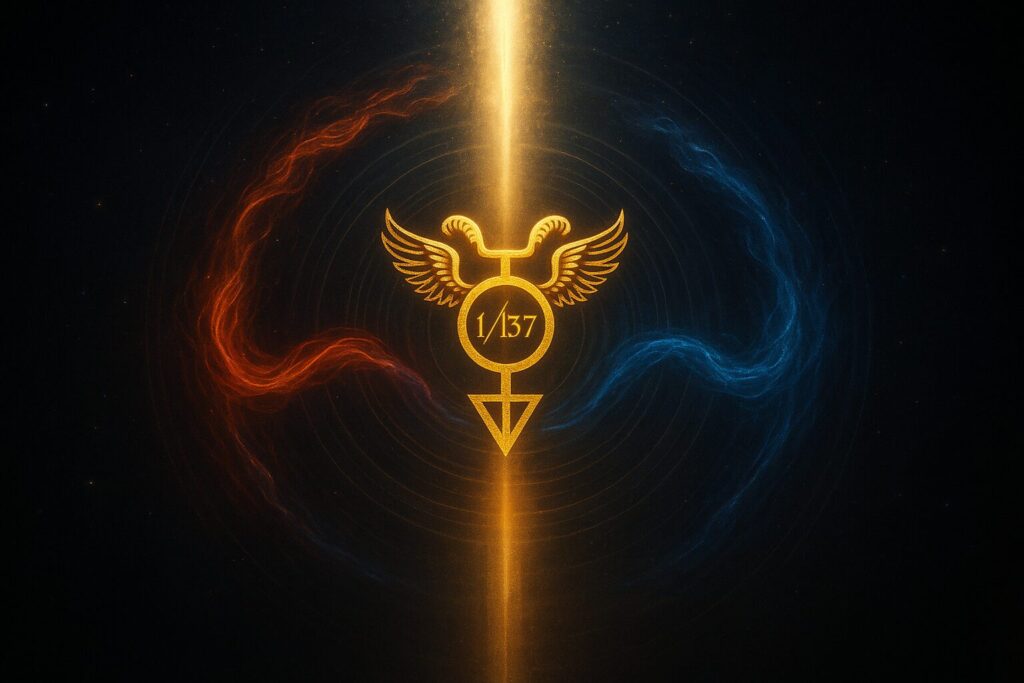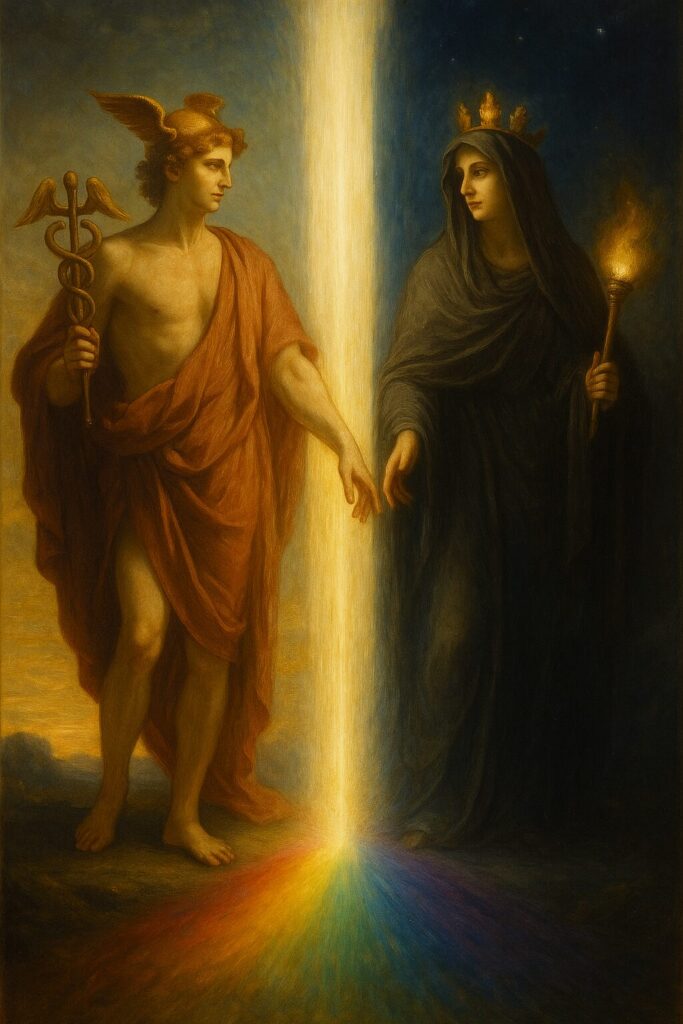The Finger of Light

Before there were stars, before there was the notion of measure, there was proportion. The gods themselves we believe came into being through number, their powers defined by harmony, their distance bridged by ratio. Creation is not built from matter but from relationship—the intervals between what is and what might be. Among these hidden intervals, one stands as a quiet threshold between the infinite and the formed. It is written not in scripture but in the geometry of the universe itself: 1/137, the fraction that binds light to substance, consciousness to appearance. It is the thread that traces through chaos so that meaning may take shape. The Finger of Light, a divinity that reveals itself through proportion.
The ancients taught that number is not invention but revelation. To number something is to confess that it already contains pattern, that it participates in order. One, they said, is the Monad—the pure source, the silence before sound, the unity that cannot be divided without echoing itself. It is the seed of being, the undisturbed potential that holds all possibilities within it. From the One, the world yearns to unfold; from the infinite stillness, the first motion stirs. When we speak of the number one, we are not counting—we are naming the quality of wholeness, the awareness that precedes form.
From this Monad springs the Three, the first shape that can stand. The Two divides casting a Shadow, but the Three reconciles. It is the triangle of existence, the rhythm of arising, duration, and return; the endless cycle of creation that sustains the cosmos in balance. In every religion the trinity recurs—father, mother, child; birth, life, death; will, love, wisdom. Three is the music of manifestation, the number of the world’s grammar. Without it, there would be motion but no stability, expression but no coherence. It is the holy act of the One discovering a way to exist without ceasing to be whole.
And then there is Seven, the sacred measure of completion. Seven tones build the octave, seven heavens climb toward the unseen, seven days mark the cycle of renewal. To the ancients it was the number of ascent—the steps from matter to meaning, from clay to awareness. In the human frame it whispered through the seven gates of the spine, the seven wandering lights of the sky, the seven transformations that refine a soul from earth to star. If One is the spark and Three the breath, Seven is the moment when breath becomes song—the world’s own exhalation into harmony.
Thus do the digits of the constant—1, 3, and 7—form a secret sentence: from unity arises existence, and existence finds its divinity in completion. The fraction 1/137 is not arbitrary; it is a mirror of creation’s unfolding. The One divides itself into relationship, is expressed through the Three, and is fulfilled through the Seven. Every temple column, every branching leaf, every spiral of the seashell obeys this whispering grammar. It is the story of manifestation written in mathematics, the Monad choosing to be many and remaining one.
Hermes, the Messenger, stands at the bright boundary of becoming. His caduceus, two serpents wound about a central staff, is the living image of polarity held in sacred conversation—light and darkness, force and form, the positive and negative charge of being. Yet when the One first divided into Two, it cast a shadow, for every illumination must reveal what it cannot wholly contain. Out of that first shimmer of contrast, Hekate arose—not as negation but as depth, the unseen current that makes reflection possible.
Where Hermes is motion between worlds, Hekate is the threshold itself—the turning of the key, the silent hinge between life and death, mind and mystery. She is the third presence born when duality meets its own echo. Together they enact the cosmic grammar of creation: light and shadow, mediator and veil, presence and possibility. The staff of Hermes is their axis—the measure that holds opposition in rhythm rather than ruin.

To name that measure 1/137 is to describe the precise harmony at which duality may coexist without collapse—the divine ratio by which shadow does not devour light but completes it. Hermes moves through it as through a doorway, carrying meaning from the invisible to the visible, from thought to flesh, from silence to sound. And Hekate, torch in hand, attends that passage, guarding the liminal fire. The Finger of Light is their shared trace across the threshold—the eternal moment when illumination and darkness meet, and from their union, the living worlds are born.
If this all sounds like poetry, it is because poetry was once a science. The universe, when viewed from within, is not machinery but music. And yet when we descend from myth into mathematics, we find that the pattern holds. The fraction is real, its value measurable in the shimmer of hydrogen’s spectral lines, in the gold of rings and crowns, in the quiet breathing of stars. It determines how fiercely light embraces the electron, how readily the immaterial agrees to become form. Were the number larger, atoms would shrink; chemistry would smother itself in its own intensity. Were it smaller, atoms would fly apart; substance would forget how to hold. Only here, at this delicate balance, can matter remain luminous and light remain tangible.
Because 1/137 is dimensionless, it belongs to no particular scale. It governs galaxies and atoms alike, the vast and the minute obeying a single law that speaks no human tongue. Its indifference to measurement is itself the miracle: it is pure relationship, detached from time, size, or distance. Such constants are the handwriting of the eternal—ratios that remain when units and names are stripped away. They are the skeleton of creation, the harmonic bones beneath the flesh of circumstance. When we recognize them, we do not impose meaning upon the world; we notice the meaning that was already there.
Even the digits return, slyly, in the structures they govern. The hydrogen atom’s first three spectral lines fall into patterns of one, three, and seven; the elemental table’s early families organize by sevens; the visible spectrum divides into seven discernible hues. The mathematics of resonance, of color and tone, of the electron’s subtle spin, all hum with the same hidden rhythm. The constant recites itself through every level of being, as if reminding the universe of its own refrain. To the physicist this is precision; to the mystic, coherence; to the witch, covenant.
And so, when the seeker whispers that 1/137 is sacred, it is not to mythologize numbers but to remember that numbers are already mythic—that they are the oldest language in which the cosmos thinks. To contemplate this constant is to practice humility before proportion: to realize that creation is not sustained by dominance or chance but by measure, by right relationship. The light that crosses the void does so according to covenant, not command. The stars endure because the infinite agrees to meet the finite halfway. Every photon is an act of faith kept.
In the stillness of study, the magic and the science meet. One peers through a telescope, the other through vision, but they behold the same boundary glowing. The equations and the incantations align; the altar and the laboratory echo one another’s geometry. The constant that holds atoms together is the same that holds prayers intact—the fraction of difference that makes connection possible. The Finger of Light is both physical law and divine gesture—the touch that joins heaven and earth without fusing them, the eternal conversation between Hermes and Hekate, motion and mystery. He carries the word across the threshold; she keeps the flame that marks its crossing. Together they are the living ratio, the unseen architecture of balance, the breath by which opposites endure.
To live in awareness of it is to practice proportion: to burn without consuming, to know without controlling, to shine without blinding. The universe is not chaos disciplined but harmony embodied. Its beauty lies not in perfection but in relationship, not in certainty but in measure. And that measure—quiet, precise, compassionate—is written as 1/137.

As above, so below.
